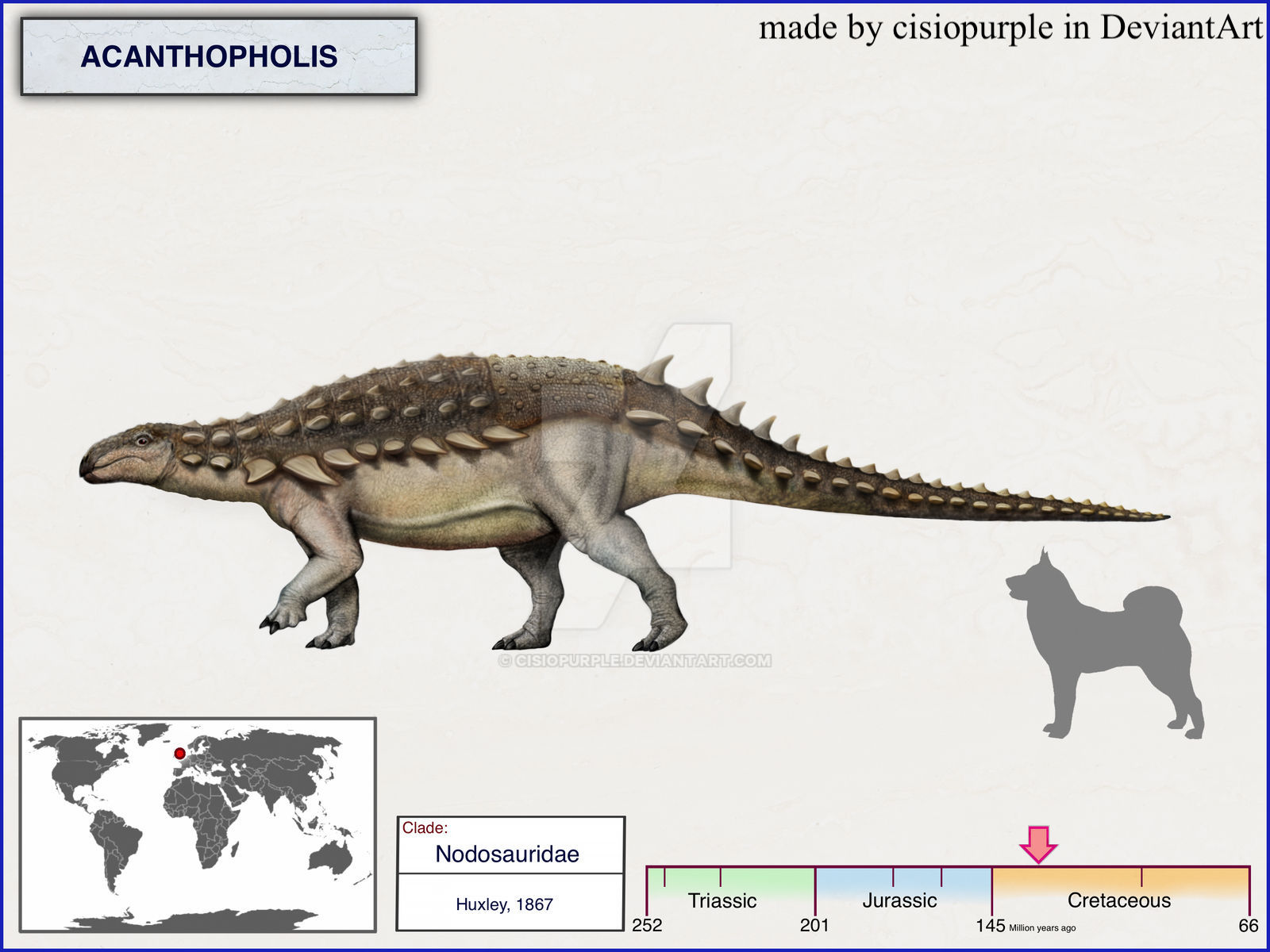Welcome to Acanthopholis

Name Definition
Spiny scales
Name Given By
Huxley, 1867
Location
Chalk Group Formation in England
Classification
Dinosauria, Ornithischia, Thyreophora, Ankylosauria, Nodosauridae, ?Acanthopholinae
Size
About 1.7 meters tall (5.5 ft), 3 - 5.5 meters long (9.8 - 18 ft), about 380 kg (840 lbs)
Temporal Range
Cenomanian age of the late Cretaceous, approximately 97 million years ago
Ecological niche
Heavily armored herbivore
Species/Sub Species
A. horrida
Diet
Like many other ankylosaurians, Acanthopholis probably low lying plants like ferns and cycads
Introduction
Acanthopholis is a genus of nodosaurid ankylosaur dinosaur that lived in England during the Late Cretaceous. Acanthopholis derives from the Greek words άκανθα, or akantha, which means 'spine' or 'thorn' and φόλις, or pholis, meaning 'scale'. The specific name, horrida, means 'frightening' in Latin.
In 1865, commercial fossil collector John Griffiths discovered some dinosaur remains, including osteoderms (also known as scutes), at the shoreline of the port town Folkestone in Kent, southeast England. He sold these remains to metallurgist (metallurgy is a field that explores the physical and chemical properties of metallic elements) Dr. John Percy. Percy brang these fossils to Thomas Henry Huxley who paid Griffiths to dig up all the fossils he could find at the site. Griffiths managed to uncover several other bones and pieces of the body armor.
In 1867 , Huxley gave these specimens the binomial name Acanthopholis horridus. In 1890, Arthur Smith Woodward ended up correcting the specific name to horrida, because the word pholis used in the generic name was feminine, so horridus was also changed to a feminine form.
In 1869, Harrier Govier Seeley officially named several new species of Acanthopholis based on remains discovered from the Cambridge Greensand unit. The species include "Acanthopholis macrocercus" which was based on specimen CAMSM B55570-55609, "Acanthopholis platypus" which was based on specimen CAMSM B55454-55461, and Acanthopholis stereocercus which was based on specimen CAMSM B55558-55569. Seeley officially described "Acanthopholis platypus" as a new species in 1871, and his later description of the sauropod Macrurosaurus semnus in 1876 he considered the metatarsals from the A. platypus holotype specimen to be conspecific with Macrurosaurus. After some time, Seeley divided up the specimen of A. stereocercus and named a species of Anoplosaurus based on a part of the specimen in 1879, A. major. Another new species of Acanthopholis, Acanthopholis eucercus, was described from 6 caudal (tail) vertebrae which was catalogued CAMSM 55552-55557. A few decades later in 1902, famous Hungarian paleontologist Franz Nopsca reallocated both species of Anoplosaurus, A. major and A. curtonotus, into Acanthopholis, resulting in Acanthopholis curtonotus and Acanthopholis major. Later in 1956, paleontologist Friedrich von Huene renamed A. platypus to Macrurosaurus platypus.
In 1999, Xabier Pereda-Superbiola and Paul M. Barrett reviewed the existing material assigned to Acanthopholis. They drew the conclusion that these specimens were nomina dubia, or dubious specimens, whose syntype (a syntype is one of a series of specimens that a genus/species is based on without any holotype being designated) specimens were made up of undiagnostic ankylosaur and ornithopod fossils. One example is that the metatarsals from the A. platypus material was eventually designated to the sauropod Macrurosaurus, but the other syntypes are not. The two also found two previously unpublished names Seeley had used to label specimens put up on display in museums: "Acanthopholis hughesii" based on SMC B55463-55490, and "Acanthopholis keepingi" which was based on SMC B55491-55526. Because they were never described officially, they were concluded to be nomina nuda. In the same year, the genus Syngonosaurus was synonymised with Acanthopholis, but was then reinstated as a genus in a 2020 study when it was concluded that Syngonosaurus and Eucercosaurus were basal iguanodontians, so Acanthopholis macrocercus was changed to Syngonosaurus macrocercus.
The osteoderm armour of Acanthopholis consists of oval-keeled plates set horizontally in the skin and long spiky osteoderms that rest along the neck and shoulder area as well as along the spine. Like any ankylosaur, Acanthopholis was a tank-like quadrupedal dinosaur and was herbivorous. It has been estimated to be around 3 - 5.5 meters long (9.8 - 18 ft) and around 380 kg (840 lbs) in weight.
Acanthopholis was initially assigned to the basal thyreophoran family Scelidosauridae proposed by Edward Drinker Cope by Huxley. When Nopsa reallocated the two Anoplosaurus species to Acanthopholis in 1902, he also created the separate family Acanthopholididae. Later, he revised Acanthopholidae to the subfamily Acanthopholinae, and in 1928 he revised Acanthopholididae to Acanthopholidae. Currently, Acanthopholis is classified in the Nodosauridae within the suborder Ankylosauria.
Sources:
- https://en.wikipedia.org/wiki/Acanthopholis
- http://www.prehistoric-wildlife.com/species/a/acanthopholis.html